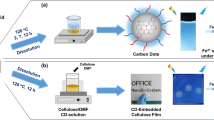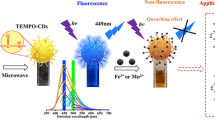Abstract
Carbon dots (CDs) as versatile carbon-based nanomaterials have attracted increasing attention because of their non-toxicity, good water solubility and photostability, and easy surface functionalization. For their wide application, it is still needed to explore moderate and facile methods for synthesizing CDs from green and inexpensive precursors. In this paper, a moderate method was developed to synthesize water-soluble CDs by ionothermal treatment of cellulose with SO3H-functionalized acidic ionic liquid as a catalyst in 1-butyl-3-methylimidazolium chloride ([Bmim]Cl). The preparation process was carried out at relatively low temperature in non-pressurized vessel. The synthesized CDs exhibit near-spherical morphology with an average diameter of 8.0 nm, and the surface is carbon and oxygen rich. The CDs have powder-blue fluorescence with excitation-dependent emission behavior and excellent stability. Moreover, the as-prepared CDs were demonstrated as an effective “turn-off” fluorescent probe for the selective detection of Hg2+ with a good linear relationship over the concentration range from 6 to 80 μM. The application of acidic ionic liquid should provide a new path for the synthesis of CDs under mild condition.







Similar content being viewed by others
References
Baker SN, Baker GA (2010) Luminescent carbon nanodots: emergent nanolights. Angew Chem Int Ed 49:6726–6744
Wang YF, Hu AG (2014) Carbon quantum dots: synthesis, properties and applications. J Mater Chem C 2:6921–6939
Shen LM, Zhang LP, Chen ML, Chen XW, Wang JH (2013) The production of pH-sensitive photoluminescent carbon nanoparticles by the carbonization of polyethylenimine and their use for bioimaging. Carbon 55:343–349
Huang H, Li CG, Zhu SJ, Wang HL, Chen CL, Wang ZR, Bai TY, Shi Z, Feng SH (2014) Histidine-derived nontoxic nitrogen-doped carbon dots for sensing and bioimaging applications. Langmuir 30:13542–13548
Gong XJ, Lu WJ, Paau MC, Hub Qin, Xin Wu, Shuang SM, Dong C, Choi MMF (2015) Facile synthesis of nitrogen-doped carbon dots for Fe3+ sensing and cellular imaging. Anal Chim Acta 861:74–84
Hu SL, Tian RX, Dong YG, Yang JL, Liu J, Chang Q (2013) Modulation and effects of surface groups on photoluminescence and photocatalytic activity of carbon dots. Nanoscale 5:11665–11671
Gao SY, Chen YL, Fan H, Wei XJ, Hu CG, Wang LX, Qu LT (2014) A green one-arrow-two-hawks strategy for nitrogen-doped carbon dots as fluorescent ink and oxygen reduction electrocatalysts. J Mater Chem A 2:6320–6325
Hu C, Yu C, Li MY, Wang XN, Yang JY, Zhao ZB, Eychmüller A, Sun YP, Qiu JS (2014) Chemically tailoring coal to fluorescent carbon dots with tuned size and their capacity for Cu(II) detection. Small 10:4926–4933
Hu YP, Yang J, Tian JW, Jia L, Yu JS (2014) Waste frying oil as a precursor for one-step synthesis of sulfur-doped carbon dots with pH-sensitive photoluminescence. Carbon 77:775–782
Wang CX, Xu ZZ, Cheng H, Lin HH, Humphrey MG, Zhang C (2015) A hydrothermal route to water-stable luminescent carbon dots as nanosensors for pH and temperature. Carbon 82:87–95
Xu Q, Zhao JG, Liu Y, Pu P, Wang XS, Chen YS, Gao C, Chen JR, Zhou HJ (2015) Enhancing the luminescence of carbon dots by doping nitrogen element and its application in the detection of Fe(III). J Mater Sci 50:2571–2576. doi:10.1007/s10853-015-8822-6
Xu X, Ray R, Gu Y, Ploehn HJ, Gearheart L, Raker K et al (2004) Electrophoretic analysis and purification of fluorescent single-walled carbon nanotube fragments. J Am Chem Soc 126:12736–12737
Xu MH, He GL, Li ZH, He FJ, Gao F, Su YJ, Zhang LY, Yang Z, Zhang YF (2014) A green heterogeneous synthesis of N-doped carbon dots and their photoluminescence applications in solid and aqueous states. Nanoscale 6:10307–10315
Sun D, Ban R, Zhang PH, Wu GH, Zhang JR, Zhu JJ (2013) Hair fiber as a precursor for synthesizing of sulfur- and nitrogen-co-doped carbon dots with tunable luminescence properties. Carbon 64:424–434
Wang XH, Qu KG, Xu BL, Ren JS, Qu XG (2011) Microwave assisted one-step green synthesis of cell-permeable multicolor photoluminescent carbon dots without surface passivation reagents. J Mater Chem 21:2445–2450
Zhuo S, Shao M, Lee S-T (2012) Upconversion and downconversion fluorescent graphene quantum dots: ultrasonic preparation and photocatalysis. ACS Nano 6:1059–1064
Li XY, Wang HQ, Shimizu Y, Pyatenko A, Kawaguchi K, Koshizaki N (2011) Preparation of carbon quantum dots with tunable photoluminescence by rapid laser passivation in ordinary organic solvents. Chem Commun 47:932–934
Deng JH, Lu QJ, Mi NX, Li HT, Liu ML, Xu MC, Tan L, Xie QJ, Zhang YY, Yao SZ (2014) Electrochemical synthesis of carbon nanodots directly from alcohols. Chem Eur J 20:4993–4999
Antonietti M, Kuang DB, Smarsly B, Zhou Y (2004) Ionic liquids for the convenient synthesis of functional nanoparticles and other inorganic nanostructures. Angew Chem Int Ed 43:4988–4992
Chen YM, Chen MM, Shi JC, Yang J, Zhang DF (2014) Fabrication of “clean” nano-structured metal materials on ionic liquid/water interface. Mater Lett 132:153–156
Smiglak M, Pringle JM, Lu X, Han L, Zhang S, Gao H, MacFarlane DR, Rogers RD (2014) Ionic liquids for energy, materials, and medicine. Chem Commun 50:9228–9250
Lu J, Yang JX, Wang JZ, Lim AL, Wang S, Loh KP (2009) One–pot synthesis of fluorescent carbon nanoribbons, nanoparticles, and graphene by the exfoliation of graphite in ionic liquids. ACS Nano 3:2367–2375
Li XH, Zhao ZW (2014) Facile ionic-liquid-assisted electrochemical synthesis of size-controlled carbon quantum dots by tuning applied voltages. RSC Adv 4:57615–57619
Zhao AD, Zhao CQ, Li M, Ren JS, Qu XG (2014) Ionic liquids as precursors for highly luminescent, surface-different nitrogen-doped carbon dots used for label-free detection of Cu2+/Fe3+ and cell imaging. Anal Chim Acta 809:128–133
Wang BG, Tang WW, Lu HS, Huang ZY (2015) Hydrothermal synthesis of ionic liquid-capped carbon quantum dots with high thermal stability and anion responsiveness. J Mater Sci 50:5411–5418. doi:10.1007/s10853-015-9085-y
Hajipour AR, Rafiee F (2010) Acidic Bronsted Ionic Liquids. Org Prep Proced Int 42:285–362
Liu YY, Xiao WW, Xia SQ, Ma PS (2013) SO3H-functionalized acidic ionic liquids as catalysts for the hydrolysis of cellulose. Carbohydr Polym 92:218–222
Ohno H, Fukaya Y (2009) Task specific ionic liquids for cellulose technology. Chem Lett 38:2–7
Wang H, Gurau G, Rogers RD (2012) Ionic liquid processing of cellulose. Chem Soc Rev 4:1519–1537
Chheda JN, Huber GW, Dumesic JA (2007) Liquid-phase catalytic processing of biomass-derived oxygenated hydrocarbons to fuels and chemicals. Angew Chem Int Ed 46:7164–7183
Tao FR, Song HL, Chou LJ (2011) Hydrolysis of cellulose in SO3H-functionalized ionic liquids. Bioresour Technol 102:9000–9006
Hu YP, Yang J, Jia L, Yu JS (2015) Ethanol in aqueous hydrogen peroxide solution: hydrothermal synthesis of highly photoluminescent carbon dots as multifunctional nanosensors. Carbon 93:999–1007
Yan HP, Tan MQ, Zhang DM, Cheng FS, Wu H, MK Fan, Ma XJ, Wang JH (2013) Development of multicolor carbon nanoparticles for cell imaging. Talanta 108:59–65
Liu NY, Liu J, Kong WQ, Li H, Huang H, Liu Y, Kang ZH (2014) One-step catalase controllable degradation of C3N4 for N-doped carbon dot green fabrication and their bioimaging applications. J Mater Chem B 2:5768–5774
Yang XM, Zhuo Y, Zhu SS, Luo YW, Feng YJ, Dou Y (2014) Novel and green synthesis of high-fluorescent carbon dots originated from honey for sensing and imaging. Biosens Bioelectron 60:292–298
Liu YS, Zhao YA, Zhang YY (2014) One-step green synthesized fluorescent carbon nanodots from bamboo leaves for copper(II) ion detection. Sens Actuators, B 196:647–652
Zhu SJ, Song YB, Zhao XH, Shao JR, Zhang JH, Yang B (2015) The photoluminescence mechanism in carbon dots (graphene quantum dots, carbon nanodots, and polymer dots): current state and future perspective. Nano Res 8:355–381
Yang Z, Xu MH, Liu Y, He FJ, Gao F, Su YJ, Wei H, Zhang YF (2014) Nitrogen-doped, carbon-rich, highly photoluminescent carbon dots from ammonium citrate. Nanoscale 6:1890–1895
Xia YS, Zhu CQ (2008) Use of surface-modified CdTe quantum dots as fluorescent probes in sensing mercury (II). Talanta 75:215–221
Hatai J, Pal S, Jose GP, Bandyopadhyay S (2012) Histidine based fluorescence sensor detects Hg2+ in solution, paper strips, and in cells. Inorg Chem 51:10129–10135
Acknowledgements
Financial support from the National Natural Science Foundation of China (No. 21173070, 21303044) is gratefully acknowledged.
Author information
Authors and Affiliations
Corresponding author
Rights and permissions
About this article
Cite this article
Wang, C., Wang, C., Xu, P. et al. Synthesis of cellulose-derived carbon dots using acidic ionic liquid as a catalyst and its application for detection of Hg2+ . J Mater Sci 51, 861–867 (2016). https://doi.org/10.1007/s10853-015-9410-5
Received:
Accepted:
Published:
Issue Date:
DOI: https://doi.org/10.1007/s10853-015-9410-5




